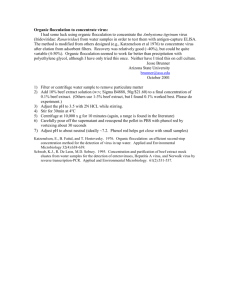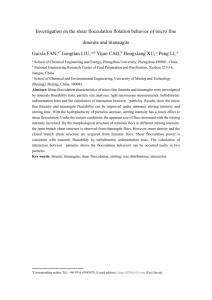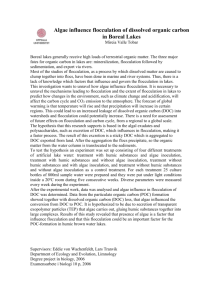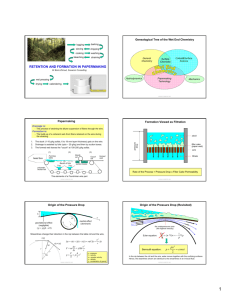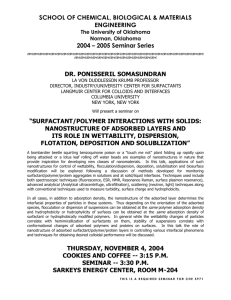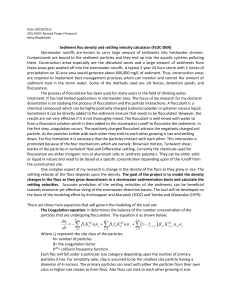determination of flocculation characteristics of natural stone powder
advertisement
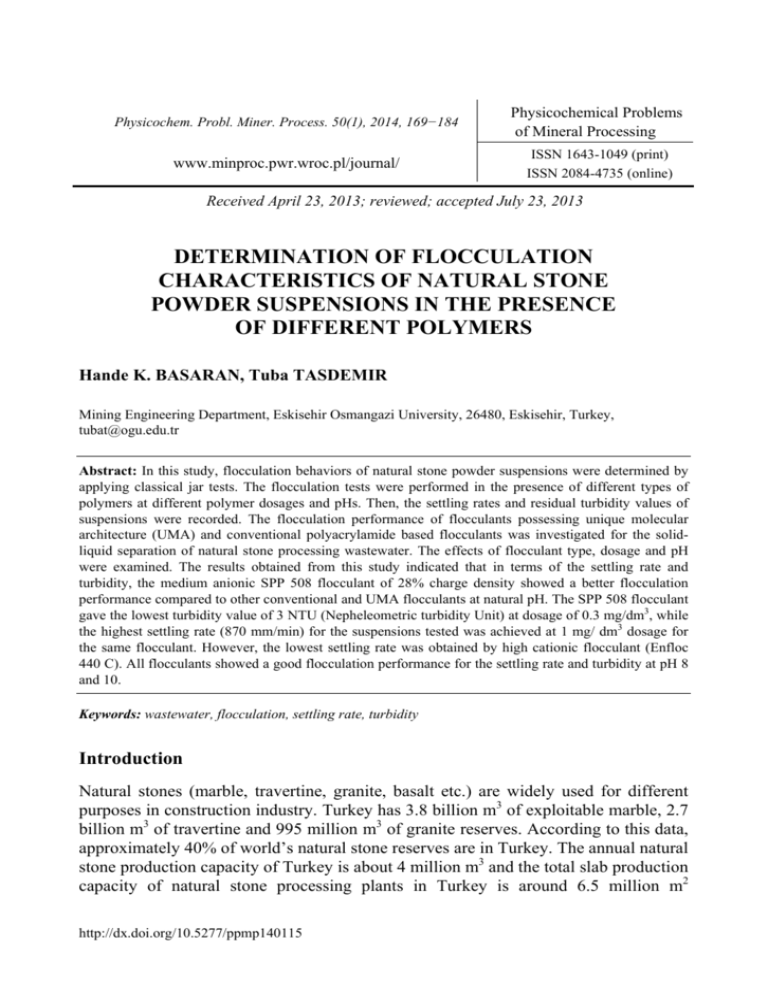
Physicochem. Probl. Miner. Process. 50(1), 2014, 169−184 Physicochemical Problems of Mineral Processing www.minproc.pwr.wroc.pl/journal/ ISSN 1643-1049 (print) ISSN 2084-4735 (online) Received April 23, 2013; reviewed; accepted July 23, 2013 DETERMINATION OF FLOCCULATION CHARACTERISTICS OF NATURAL STONE POWDER SUSPENSIONS IN THE PRESENCE OF DIFFERENT POLYMERS Hande K. BASARAN, Tuba TASDEMIR Mining Engineering Department, Eskisehir Osmangazi University, 26480, Eskisehir, Turkey, tubat@ogu.edu.tr Abstract: In this study, flocculation behaviors of natural stone powder suspensions were determined by applying classical jar tests. The flocculation tests were performed in the presence of different types of polymers at different polymer dosages and pHs. Then, the settling rates and residual turbidity values of suspensions were recorded. The flocculation performance of flocculants possessing unique molecular architecture (UMA) and conventional polyacrylamide based flocculants was investigated for the solidliquid separation of natural stone processing wastewater. The effects of flocculant type, dosage and pH were examined. The results obtained from this study indicated that in terms of the settling rate and turbidity, the medium anionic SPP 508 flocculant of 28% charge density showed a better flocculation performance compared to other conventional and UMA flocculants at natural pH. The SPP 508 flocculant gave the lowest turbidity value of 3 NTU (Nepheleometric turbidity Unit) at dosage of 0.3 mg/dm3, while the highest settling rate (870 mm/min) for the suspensions tested was achieved at 1 mg/ dm3 dosage for the same flocculant. However, the lowest settling rate was obtained by high cationic flocculant (Enfloc 440 C). All flocculants showed a good flocculation performance for the settling rate and turbidity at pH 8 and 10. Keywords: wastewater, flocculation, settling rate, turbidity Introduction Natural stones (marble, travertine, granite, basalt etc.) are widely used for different purposes in construction industry. Turkey has 3.8 billion m3 of exploitable marble, 2.7 billion m3 of travertine and 995 million m3 of granite reserves. According to this data, approximately 40% of world’s natural stone reserves are in Turkey. The annual natural stone production capacity of Turkey is about 4 million m3 and the total slab production capacity of natural stone processing plants in Turkey is around 6.5 million m2 http://dx.doi.org/10.5277/ppmp140115 170 H. K. Basaran, T. Tasdemir (www.enerji.gov.tr). Recently, there is a significant increase in production level for both domestic consumption and export markets in Turkey. However, marble factories use large amounts of water during the cutting, washing and polishing processes.Water is used as a cooler during cutting of marble blocks. The cutting of a block, for instance, produces approximately 25–40% of the weight of the block as fine particles (Onenc,2001). The particles in the wastewater are generally treated by simple solid– liquid separation. The inefficiency of the employed techniques results in the presence of fine particles in recycled water, which cause polishing problems during processing. In addition, the suspended particles in recycled water may also result in pipe clogging(Acar, 2001; Celik and Sabah, 2008). The purpose of the flocculation process is to form aggregates or flocs from finely dispersed particles in the presence of natural or synthetic polymeric substances (flocculants). There are many types of polymeric flocculants used in various solidliquid separation processes. The polymers are characterized by their ionic nature: cationic, anionic and non-ionic. The ionic polymers usually can be called polyelectrolytes. The most important properties of polymeric flocculants are the molecular weight and charge density. The molecular weight values range from a few thousand up to tens of millions. The charge density can be expressed in terms of mole percent of charged groups. The polyelectrolyte charge density values are regarded as low, medium or high if the mol% of ionic groups are approximately:10%, 25-40%, and 50–100%, respectively (Gregory, 2005; Gregory and Barany, 2011). The cationic flocculants are usually of lower molecular weight and are only used in the solid-liquid separation, where the fast sedimentation rates associated with the use of high molecular weight products ensured their dominance. The anionic and nonionic flocculants are currently used in mineral and natural stone tailing systems (Ipekoglu, 1997; Hendersan and Wheatley, 2007). The flocculants bring together coagulated particles into larger aggregates and settle them. The polymer bridging and charge neutralization are the commonly encountered mechanisms in flocculation. Bridging flocculation occurs as a result of adsorption of individual polymer chains onto several particles simultaneously, forming molecular bridges between the adjoining particles in a floc. The charge neutralization becomes a major mechanism for polyelectrolytes, where significant particle surface sites with charge opposite to that of the ionic polymer functional groups are present. The flocculants are known to adsorb on particle surface through hydrogen bonding, ion binding, electrostatic interactions, chemical bonding, hydrophobic interactions and van der Waals forces (Somasundaran and Das, 1998; Hogg, 2000; Mpofu et al., 2003; Bratby, 2006; Gregory and Barany, 2011). Flocculation of fine particle suspensions depends on a number of factors, which include type, molecular weight and charge density (ionization degree) of the flocculant, mineralogical composition and particle size of solid particles, pH and chemical composition of solutions (Ipekoglu, 1997; Somasundaran and Das, 1998; Hocking et al., 1999; Besra et al., 2000; Sworska, et al., 2000 a; Yarar, 2001; Sabah Determination of flocculation characteristics of natural stone powder suspensions… 171 and Cengiz, 2004; Ersoy, 2005; Gregory, 2005; Tripathy and Ranjan, 2006; Sabah and Erkan, 2006; Hendersan and Wheatley, 2007; Cengiz et al., 2009; Gregory and Barany, 2011; Tasdemir et al., 2011; Tasdemir and Kurama, 2012; Sabah and Aciksoz, 2012). The process also depends strongly on hydrodynamic conditions. The properties of floc aggregates are largely determined bymixing conditions (Gregory and Guibai, 1991; Rossini et al., 1999; Sworska, et al., 2000b; Tasdemir and Tasdemir, 2012). To achieve efficient a solid-liquid separation, different types of flocculants are used according to waste material type, since the flocculation processes are very sensitive to properties such as the surface charge of particles, solid-liquid or solidpolymer interaction, presence of different ion types in solution, structure of polymer and amount of adsorption of polymer on the particle surface. Each of them determines the flocculation rate and efficiency. Therefore, determination of the flocculation behavior of the suspensions is very important. The standard polymer molecules of high molecular weight are considered as linear structures with two dimensions. Present day developments for polyacrylamide-based flocculants are likely to be based on the “molecular architecture” concept. This will enable a flocculant technology to produce the performance required to meet increasing and changing demands for solid–liquid separation. In recent years, a new generation of flocculants namely the unique molecular architecture (UMA) was introduced in addition to conventional flocculants to enhance the flocculation process (Pearse et al., 2001). It is claimed, that this technology covers highly branched and interactive polymer chains. They produce flocs of different characteristics than those formed by conventional flocculants. Denser and stronger flocs containing less water (Pearse, 2003) are produced with the UMA floculants. In the literature, many studies were conducted to determine the flocculation behavior of natural stone suspensions(Bayraktar et al. 1996; Seyrankaya et al., 2000; Nishkov and Marinov, 2003; Arslan et al., 2005; Ersoy, 2005; Tasdemir and Kurama, 2012; Sabah and Acıksoz,2012). However, from most of them only the marble effluents were used. These studies reported that high molecular weight of anionic polymers (e.g. polyacrylamides) were commonly used in dewatering of negatively charged natural stone effluent and gave the best results on the settling rate and water clarity. A number of studies with new unique molecular architecture type flocculants were reported in mineral processing for dewatering. These studies are related to comparison of the flocculation performances of the new generation UMA and conventional flocculants investigated in dewatering of tailings containing clay minerals (Pearse et al., 2001; Weir and Moody, 2003), coal preparation (Cengiz et al., 2004) and ceramic plant tailings (Cengiz et al., 2009). The UMA flocculants showed higher flocculation performance than the conventional flocculants in those studies.On the other hand, a limited number of researches were carried out for the flocculation performance of waste water containing natural stone fine powders by using the UMA types. Only Sabah and Aciksoz (2012) investigated the flocculation performance of a new 172 H. K. Basaran, T. Tasdemir generation of flocculants (Magnafloc 5250 and 6260) and compared them with results with conventional (acrylamide SB 1836) for the solid-liquid separation of travertine processing wastewater. They reported that the anionic UMA flocculants showed better performance than conventional anionic flocculant (SB 1836)which is used in the travertine processing plant. In recent years, the export potential of the natural stone industry in Turkey developed rapidly in parallel with new investments. Increased water pollution during cutting and polishing of the stones forced material suppliers to invest in new modifications on existing techniques to improve the treatment process and high performance flocculants. For this reason in this study, the sedimentation behavior of natural stone powder suspensions containing a mixture of fines such as marble, granite and travertine was investigated by using a new UMA Magnafloc polymers and conventional flocculants based on polyacrylamide. The effects of the key parameters, involving suspension pH, flocculant type and dosage, and charge density were studied on residual turbidity and settling rate for suspensions. Materials and Method The natural stone powder used for the flocculation tests was obtained from a local natural stone processing plant in Eskisehir region (Turkey). The plant processes different types of marbles, granite and travertine etc. blocks, therefore, the cutting fines contain mixed powders with different minerals. The sample was taken in its original waste mud state from the plant waste area and then dried. Thus mud contained coarse and fine cutting waste powders. According to the initial sieve analysis of sample, the particles are almost below 300 micrometers and 74.2% was below 20 micrometers. Since the settling rate of –20 µm powder is the most problematic and this size is considered as slime size, the dried particles were sieved by 20 µm sieve. Therefore, sieved -20 µm powders were used in the experiments to select the most suitable flocculant type for this mixed material. The flocculation tests were conducted with suspensions of natural stone powders. The natural stone powder suspensions used in the experiments were artificially prepared as 1% (wt./vol.) in 500 cm3 tap water. The chemical composition of the natural stone powder was analyzed by a X-ray fluorescence (XRF) using a Rigaku ZSX Primus device. A mineralogical analysis of particles was characterized by X-ray diffraction (XRD) using a Rigaku Rint-2000 model diffractometer. The XRDand XRF results are given in Fig.1 and Table 1, respectively. According to the XRD data, the sample is predominately composed of calcite and quartz and also peaks of albite, muscovite and microcline occur. The XRF results showed that CaO and SiO2 contents of the sample were 42.32% and 16.81%, respectively. 173 Determination of flocculation characteristics of natural stone powder suspensions… 6000 C: calcite Q: quartz A: albite M: muscovite Mi: microline Intensity (Counts) 5000 4000 C 3000 2000 1000 M Q Mi C C A C C CC C C C 0 10 20 30 40 50 60 70 Two-Theta (deg) Fig. 1. X-ray diffraction pattern of natural stone powders Table 1 Chemical analysis of the natural stone powders by XRF CaO% SiO2% Al2O3% K2O% Na2O% MgO% Fe2O3% TiO2% LOI% 42.32 16.81 3.5 1.14 1.06 0.87 0.73 0.09 33.48 Cumulative undersize (%) The size distribution of the sample was determined using a Malvern Mastersizer Hydro 2000G Particle Size Analyzer and result is given in Fig. 2. It was measured that d90, d50and d10of the solid particles in the suspension by volume were 27.71, 6.84 and 1.29 µm, respectively. 100 90 80 70 60 50 40 30 20 10 0 1 10 Size (micrometers) 100 Fig. 2. Particle size distribution of sample used by laser diffraction The zeta potential measurements for the fine particles were made by a Malvern Nano-Z model zetameter device using laser Doppler velocimeter principle. The using double distilled water was used for preparation of solid suspension in 0.1 % solid 174 H. K. Basaran, T. Tasdemir ratio. The zeta potential of natural stone powder versus pH of suspension is presented in Fig. 3.Figure 3 shows that there is no zero zeta potential value (zpc) indicating the isoelectric point (iep) at different pH values adjusted. The highest zeta potential (–36.6 mV) was measured at pH 11. It indicates that the suspension was stable, whereas at natural pH of 8 the zeta potential of suspension was about –13.3 mV. Fig. 3. Variation of zeta potential of natural stone powders The pH, conductivity, temperature measurements ofnatural stone powder suspension were measured with Orion 5 star multimeter device. After settling time of 15 minutes the turbidity of suspensions was measured using a HF Scientific Turbidimeter, which gives the turbidity result as nepheleometric turbidity unit (NTU). The hardness of water was determined by a volumetric method. Properties of tap and distilled waters and natural stone powder suspension used in experiments aregiven Table 2. The pH and specific conductivity of the distilled water used for the preparation of stock solutions of the flocculant were 6.1 and 34 µS/cm, respectively. The properties of the tap water used in the sedimentation tests were pH 7.8, specific conductivity 709 µS/cm, turbidity 0.38 NTU. The natural pH value and conductivity of suspension were about 8 and 580 µS/cm respectively. The initial turbidity of natural stone powder suspension was measured as 12000 NTU and residual turbidity as 295 NTU after sedimentation time15 min. The solutions of polymer (0.01%) were prepared using distilled water. A 1 M HCl and NaOH (analytical grade) solutions were used to adjust the suspension pH. Table 2. Properties of tap and distilled waters and natural stone powder suspension used in experiments pH Turbidity (NTU) Conductivity (µS/cm) Temperature (oC) French hardness of water (oF) Distilled water Tap water Natural stone powder suspension 6.1 0.14 34 18.4 – 7.8 0.38 709 17.9 30 7.96 12000 580 17.9 35.6 Determination of flocculation characteristics of natural stone powder suspensions… 175 The flocculation experiments of the natural stone suspensions were carried out with a new UMA Magnafloc type flocculants and some conventional flocculants, which consist of different types of high molecular weight polyacrylamide based polymers. The polymers used for the tests are collected in Table 3. The magnafloc flocculants were provided by BASF Specialty Chemical., SPP by the Superkim and Enfloc by ECS Chemistry. Table 3. Polymers with high molecular weight used in the experiments Commercial name Type Charge Density (%) Supplier SPP 508 Enfloc 320A Magnofloc 5250 (UMA) Magnofloc 4240 (UMA) Enfloc 440C Enfloc 420C SPP N 134 anionic anionic anionic anionic cationic cationic nonionic 28 (medium) 20 (low) 30 (medium) 40 (medium) 55 (high) 15 (low) – Superkim ECS Chem. Basf Basf ECS Chem. ECS Chem. Superkim The flocculation experiments were carried out using a conventional jar test apparatus (Velp Scientifica FC6S) with a speed control. The desired amount of flocculant was added to the suspensionand the beakers were agitated at fixed mixing time (2 min) at 200 rpm of speed. After agitation, the flocculated suspension was poured into 500 cm3 graduated cylinder and was allowed to settle. The height of the slurry and water interface was measured as a function of time and then the settling rates were calculated from the slope of the straight line portion of the plot of pulp level versus settling time. After 15 minutes of settling time, the residual turbidity values of the supernatant solutions were measured by using a Turbidimeter apparatus. The principal purpose of the flocculation experiments was to establish the optimal conditions for floc formation. Results and discussion Effect of flocculant type and dosage The flocculation tests were performed in the presence of different types of polymers using the new UMA Magnafloc polymers and conventional flocculants based on polyacrylamide at different polymer dosages, which varied from 0.1 to 5mg/dm3 at natural pH of 8. Figure 4shows the residual turbidity values as a function of polymer dosage for each type of polymer with different charge densities. The residual turbidity of the suspension decreases with an increase of polymer dosage to a certain dosage, and further increases with increasing dosages for all flocculants. It was suggested that optimum flocculation occurs, when half surface of particle is covered with 176 H. K. Basaran, T. Tasdemir polyelectrolytes as described in many studies (Pefferkorn, 1999; Sworska et al., 2000 a; Hogg, 2000; Besra et al., 2004; Ersoy, 2005; Tripaty and Ranjan de, 2006; Boltoa and Gregory, 2007). It can be explained by the excess adsorption of polymer molecules with each other or a complete coverage of the particle surface by polymer molecules at higher dosages and steric repulsion of the adsorbed layers. Hence, the polymer to particle surface bridging mechanism is prevented (Gregory, 2005; Bratby, 2006; Gregory and Barany, 2011). According to Fig. 4, in the flocculation process performed at natural pH, the medium anionic flocculant SPP 508 among polymers showed the lowest turbidity value of 3 NTU at the lowest dosage of 0.3 mg/dm3, whereas other flocculants showed the lowest turbidity values at higher dosage (1 mg/dm3) (Kilic, 2012). Fig. 4. Effect of flocculant type and dosage on residual turbidity (pH 8) The settling rate curves for natural stone suspension as a function of flocculant dosage at natural pH of 8 for each flocculant type are given in Figure 5. The results of settling tests indicate that type of flocculant, charge density and dosage of the flocculant has an important effect on settling rates. From Fig. 5, it can be seen that the settling rate of particles increases rapidly with an increase in flocculant dosage for all flocculants up to a 1 mg/dm3 dosage. After this dosage, the increase in the settling rate decreases. The settling rate increased with increasing flocculant dosage for all flocculants except the anionic SPP 508 and cationic Enfloc440 C. The settling rate for SPP 508 and 440 C reached the maximum at 1 and 3 mg/dm3 flocculant dosage, respectively, and then further increase in the dosage leads to decrease in the settling rate. The best settling performance (870 mm/min) for the suspensions tested was Determination of flocculation characteristics of natural stone powder suspensions… 177 achieved at 1 mg/dm3 dosage by the medium anionic SPP 508 flocculant. However, the lowest settling rates were obtained by the high cationic flocculant (Enfloc 440 C). Since the flocs formed by Enfloc 440 C polymer were fairly small, they had a slowsettling rate. At low polymer dosages, the settling rates were low due to insufficient polymer available for bridging particles together and the flocs were not large enough to provide adequate settling rates. As the polymer concentration increased, more particles were bridged and bigger flocs were obtained, hence a significant increase in the settling rates resulted. It was found that settling rates or hence floc sizes obtained at the same polymer dosage for each flocculant type were importantly different. It is supposed that these differences result from different mechanisms of polymer adsorption on particle surface and conformation of polymer chain in suspension (Yu and Somasundaran, 1996; Somasundaran and Krishnakumar, 1997; Hogg, 1999; Rattanakawin and Hogg, 2001; Taylor et al., 2002; Mpofu et al., 2003; Besra et al., 2004). Fig.5. Effects of flocculant type and dosage on settling rate (pH 8) The polymer bridging and charge neutralization are the commonly encountered mechanisms in flocculation (Gregory, 2005; Gregory and Barany, 2011). Bridging flocculation occurs as a result of adsorption of individual anionic polymer chains onto several particles. The most important property of the polymer bridging mechanism is to produce large sized flocs and high settling rates (Hogg, 1999; Biggs et al., 2000; Rattanakawin and Hogg, 2001).There are many possible mechanisms (hydrogen bonding, cation bridging, van der Waals forces etc.) for anionic polymers adsorption on the particle surface. Flocculation by the anionic flocculants occurs even though the 178 H. K. Basaran, T. Tasdemir flocculant and natural stone particles have the same charge. In the flocculation tests carried out by using the anionic flocculants, it is assumed that adsorption of anionic polymers on particles is the most often attributed to cation bridging. This phenomenon was stated by several authors (Sworska, et al., 2000a; Yarar, 2001; Bentli, 2010; Sabah and Aciksoz, 2012). The divalent cations act as bridges between the anionic carboxyl groups (-COO–) of polymer and the negative particlesurfaces. Sabah and Aciksoz (2012) reported that when French hardness of water is less than 9 ºF, interaction between polymer molecules and particles weakens. The hardness of the natural stone suspensions tested was measured as 35.6 ºF due to its high ion (Ca+2 and Mg+2) concentrations (Table 2). This value is above the proposed limit value of 9 oF (Sabah and Erkan, 2006; Sabah and Aciksoz, 2012). Therefore, the present of divalent cations in the suspension contributes to better flocculation performance obtained with the medium anionic flocculant. The cationic flocculants adsorb on the surfaces of negatively charged particles through the charge neutralization mechanism because of electrostatic attraction between oppositely charged ionic groups. In many studies, the charge neutralization mechanism is reported to produce relatively small flocs and slow settling rates (Gregory, 2005; Tripaty and Ranjan DE, 2006; Sabah and Erkan, 2006; Bolto and Gregory, 2007; Gregory and Barany, 2011). In the case of nonionic polymers, the most likely mechanism of adsorption is through hydrogen bonding between the oxygen atoms associated with hydrated metal ions at the particle surface and amide groups (-CONH2) on the polymer (Sabah and Cengiz, 2004; Bolto and Gregory, 2007). The effectiveness of polymers as the bridging flocculants depends greatly on their properties. The most important characteristics of polymeric flocculants are molecular weight and charge density (ionization degree). The molecular weight directly influences the effective size of molecules in solution and in the adsorbed state. Polymers with higher molecular weight are found to be more effective flocculants. For a similar reason, it is generally found that linear polymers are more effective than branched or cross-linked structures for a given molecular weight (Gregory, 2005; Gregory and Barany, 2011). Therefore, it can explain that high molecular weight and linear anionic flocculants(SPP 508) are more effective than highly branched anionic UMA flocculants consisting of the same charge density. Sabah and Acksoz (2012) tried to flocculate travertine fines by using three types of anionic flocculants. They concluded that high charge density of the UMA type flocculant (Magnafloc 6260) gave the best results in terms of turbidity and settling rate while medium anionic UMA (Magnofloc 5250), which is the same flocculant used in this study and conventional medium anionic flocculants (SB 1836) showed poor performance. Many studies reported that high molecular weight polymers form large size but less compact flocs, whereas low molecular weight polymers form small and more compact flocs (Rattanakawin and Hogg, 2001; Taylor et al., 2002; Sabah and Erkan, 2006; Gregory and Barany, 2011). Determination of flocculation characteristics of natural stone powder suspensions… 179 The charge density can also have a large influence on the bridging effectiveness. If the charge density is high, there would be difficulty in adsorbing onto particles of the same sign of charge (as in the case of anionic polymer and negative particles). Also, the adsorbed polymer configuration may not favour bridging, when the charge density is high. However, some degree of charge is beneficial since the repulsion between charged segments gives expansion of the chain, as explained earlier, and this should enhance the bridging effect. For these reasons, there is often an optimum charge density for bridging flocculation (Ersoy, 2005; Sabah and Erkan, 2006; Bolto and Gregory, 2007; Gregory and Barany, 2011). In this study, the best flocculation performance is obtained with polymer of 28% charge density (medium anionic SPP 508) for flocculation of natural stone suspension. Similar result was found by Ersoy (2005) where 28% and 34% anionic polymers were found suitable in terms of the settling rate and turbidity for travertine and marble suspension, respectively. Effect of pH pH of suspension will not only affect the surface charge and stabilization of particles, but also affect the conformation of flocculants and adsorption of them onto particles in the suspension. Thus pH may directly affect the flocculating power of polymer. Figure 6 indicates the influence of suspension pH on the residual turbidity of natural stone suspension at constant flocculant dosage of 0.3 mg/dm3 for all flocculants. It is clearly seen that natural pH 8 and 10 give good flocculation performance for all flocculants, whereas at both low (6) and high (12) pH values higher supernatant turbidity values are obtained (Kılıç, 2012). It was found that the residual turbidity of the supernatant solution decreased to the target level 20 NTU’s (generally accepted turbidity level for recycled water in natural stone processing) at all pH values except 12. In the flocculation process, the potential of particle surface profoundly affects the stabilization or destabilization of the suspended particles, and therefore the efficiency of the flocculation process. In general., the stability of the particles is determined by analyzing the typical zeta potential versus pH plot. When the magnitude of zeta potential is high, the electrostatic repulsion between particles causes the particles to disperse readily and form stable suspensions. For lower magnitude of zeta potential., the repulsive force between the particles is reduced so that the particles come closer and form agglomerates resulting in faster settling characteristics. If zeta potential values of the particles are higher than the range of ±30 mV, they are assumed to fall in a stable region (Yarar, 2001). The plot of zeta potential versus pH given in Fig. 3 shows that the zeta potential values of the natural stone particles varied between -10.5 mV and 9.36 mV at pH between 6 and 10.The particles in the suspension are assumed to fall in the unstable region due to insufficient negative surface potentials and adsorption of H+ ions onto negative charge centers of particles lead to the enhances flocculation of particles. It explains a good response of natural stone particles to the flocculation process given in Fig. 6. 180 H. K. Basaran, T. Tasdemir For pH above 10, the zeta potential of particles increases to -36.6 mV. It indicates that the suspension is stable (Fig. 3). It is know that high molecular weight polymers are not effective in destabilizing such dispersed particles (Hogg, 1999). According to Hogg (1999), the addition of high molecular weight polymers to stable dispersions leads to the development of bimodal floc size distributions consisting of dispersed particles. Fig. 6. Effects of polymer type and suspension pH on residual turbidity (polymer dosage 0.3 mg/dm3) Fig. 7. Effects of polymer type and suspension pH on the settling rate (polymer dosage 0.3 mg/dm3) Determination of flocculation characteristics of natural stone powder suspensions… 181 Figure 7 depicts the effect of pH on settling rates of natural stone suspensions at a constant flocculant dosage of 0.3 mg/dm3. It can be seen that the settling rate of natural stone fine particles decreased at high and low pH values, while the settling rate significantly increased at pH 8 and 10 for all flocculants. The highest settling rates of 455, 392 and 445 mm/min were obtained with anionic SPP 508, Magnafloc 5250 and nonionic SPP N 134 flocculants respectively at pH 10 compared to other flocculants. The settling rates for other flocculants reached maximum at natural pH 8 of suspension. Figures 6 and 7 demonstrate that both settling rate and residual turbidity of suspension are strongly dependent upon pH. This dependence arises from several factors. First, the high suspension pH increases the electrical double layer (EDL) repulsive forces between natural stone particles and anionic or nonionic polymers due to increase in the zeta potential of particles. Therefore, an attachment of polymer chain to surface can become difficult and this may adversely affect flocculation. Secondly, the conformation of the adsorbed polymer on natural stone particle surfaces, whether stretched or coiled, has a marked influence on flocculation and the polymer conformations can be changed by adjusting pH. Many studies reported that the activity of polymers is related to uncoiling or extension of the polymers (Yu and Somasundaran, 1996; Somasundaran and Krishnakumar, 1997; Sworska et al., 2000a; Taylor et al., 2002; Besra et al., 2004; Sabah and Erkan, 2006; Boltoang Gregory, 2007). At low pH values, the anionic polymers coil up and they do not adsorb on the particles or cause high polymer consumption. Increasing pH causes elongation of macromolecules through solution due to the electrostatic repulsion among negatively charged carboxyl groups and they have stretch conformation at high pH (Besra et al., 2004). That stretched conformation is very important since bridging mechanism is fully activated and flocculation performance increases due to available active polymer segments. This in turn will contribute to the enlargement and strength of the flocs. Conclusion Flocculation tests were carried out in the presence of different types of polymers at different polymer dosages and pHs. Flocculation and clarification behavior of natural stone suspensions were studied by determining the residual turbidity values and the settling rates of suspensions. The condition for the maximum settling rate and the minimum turbidity after settling was observed at optimum flocculant dosage for each flocculant. The critical amount of flocculant under these conditions was dependent on the type, molecular weight and charge density of flocculant and the solution pH. It was found that type and dosage of the flocculant has an important effect on the settling rate and turbidity. All flocculants used in the flocculation tests, substantially reduced the turbidity of natural stone suspensions and the settling rate of the particles increased with an increase in flocculant dosage. However, it was determined that in terms of the settling rate and turbidity, the medium anionic SPP 508 flocculant of 28% charge 182 H. K. Basaran, T. Tasdemir density showed a better flocculation performance compared to the other conventional and UMA flocculants at natural pH of natural stone suspension SPP 508 showed the lowest turbidity value of 3 NTU at the lowest dosage of 0.3 mg/dm3. Considering only the settling rate, the large size flocs and the maximum settling rate of 870 mm/min for the suspensions tested was achieved at 1 mg/dm3 dosage by medium anionic SPP 508 flocculant. However, relatively small flocs and the lowest settling rate was obtained by the high cationic flocculant Enfloc 440 C. The flocculation test results showed that the conformation and the charge density of polymerat high and low pH regimes played a crucial role in flocculation of the natural stone particles. All flocculants showed the good flocculation performance for the settling rate and turbidity at pH 8 and 10. References ACAR H., 2001, Attention must be paid to matters during the establishment and the running of a wastewater clarity unit for a marble processing plant, The Third Marble Symposium, 289–296, Ankara. ARSLAN E.I., ASLAN S., IPEK U., ALTUN S., YAZIOGLU S. 2005, Physico-chemical treatment of marble processing wastewater and recycling of its sludge. Waste Management Research, 23, 550– 559. BAYRAKTAR I., ONER M., KARAPINAR N., SAKLAR S. 1996, Wastewater treatment in the marble industry. In M. Kemal., V. Arslan, A. Akar, & M. Canbazoğlu (Eds.), Changing scopes in mineral processing, 673–677, Rotterdam,NL: Balkema. BENTLI I., 2010, The effect of electrolytes in flocculation of coal washing plant talings,Ekoloji, 71–77. BESRA L., SENGUPTA D.K., ROY S.K., 2000, Particle characteristics and their influence on dewatering of kaolin, calcite and quartz suspensions, Int. J. Miner. Process. 59, 89–112. BESRA L., SENGUPTA D.K., ROY S.K., AY P., 2004, Influence of polymer adsorption and conformation on flocculation and dewatering of kaolin suspension, Separation and Purification technology, 37, 231–246. BIGGS S., HABGOOD M., JAMESON G.J., YAN Y., 2000, Aggregate structures formed via a bridging flocculation mechanism, Chemical Engineering Journal., 80, 13–22. BOLTOA.B., GREGORY J., 2007, Organic Polyelectrolytes in Water Treatment, Water Research, 41, 2301–2324. BRATBY J., 2006,Coagulation and Flocculation in Water and Wastewater Treatment, Published by IWA Publishing, London. CENGIZ I., SABAH E., ERKAN Z.E., 2004, A study on the flocculation performances of traditional and UMA technology polymers, Madencilik,43, 15–23. CENGIZ I., SABAH E., OZGEN S., AKYILDIZ H., 2009, Flocculation of Fine Particles in Ceramic Wastewater Using New Types of Polymeric Flocculants, Journal of Applied Polymer Science, 112, 1258–1264. CELIK, M.Y., SABAH E., 2008,Geological and technical characterization of Iscehisar (Afyon-Turkey) marble deposits and the impact of marble waste on environmental pollution. Journal of Environmental Management, 87, 106–116. ERSOY, B., 2005, Effect of pH and Polymer Charge Density on Settling Rate and Turbidity of Natural Stone Suspensions, International Journal of Mineral Processing, 75, 207– 216. GERGORY, J., 2005, Particles in water: Properties and Process, University College London, UK. GREGORY J., GUIBAI L., 1991, Effects of dosing and mixing conditions on polymer flocculation of concentrated suspensions, Chemical Engineering Communications, V: 108, 3–21. Determination of flocculation characteristics of natural stone powder suspensions… 183 GREGORY J., BARANY S., 2011, Adsorption and flocculation by polymers and polymer mixtures, Advances in Colloid and Interface Science, 169, 1–12. HENDERSON J.M., WHEATLEY A.D. 2007, Factors Affecting the efficient flocculation of tailings by polacrylamides, Coal Preparation, 1987, V 4, 1-49. HOCKING M.B., KLIMCHUK K.A., LOWEN S., 1999, Polymeric flocculants and flocculation, Polymer Reviews, 39:2, 177-203. HOGG R., 2000, Flocculation and dewatering. International Journal of Mineral Processing, V:58, pp223236. HOGG R., 1999, The role of polymer adsorption kinetics in flocculation, Colloids and Surfaces A: Physicochemical and Engineering Aspects, 146, 253–263. IPEKOGLU U., 1997, Dewatering and Methods. Dokuz Eylül University, Mining Faculty Impress, No: 179, İzmir. KILIC H., 2012, Treatment of Natural Stone Wastewaters by Flocculation and Floc-Flotation Methods, MSc Thesis, Eskişehir Osmangazi University, Turkey. MPOFU P., ADDAI-MENSAH J., RALSTON J., 2003, Investigation of the effect of polymer structure type on flocculation, rheology and dewatering behavior of kaolinite dispersions, Int. J. Miner. Process. 71, 247–268. NISHKOV, I., MARINOV, M. 2003,Calcium carbonate microproducts from marble treatment waste. In L.Kuzey, I.Niskov, A. Boteva, D. Mochev (Eds.), Mineral processing in the 21st century (pp. 700– 705), Djev Trade, Sofia. ONENC, D.I., 2001, The block becoming powder and hopes. Marble, 30, 66–68. PEARSE, M.J.,WEIR S., ADKINS S.J AND MOODY G.M., 2001, Advances in mineral flocculation, Mineral Engineering, 14, 1505-1511. PEARSE, M.J., 2003, Historical use and future development of chemicals for solid–liquid separation in the mineral processing industry, Minerals Engineering, V: 16, 103–108. PEFFERKORN, E.,1999, Polyacrylamide at solid/liquid interfaces, Journal of Colloid and Interface Science, 216, 197-220. RATTANAKAWIN, C., HOGG R., 2001, Aggregate size distributions in flocculation, Colloids and Surfaces A: Physicochemical and Engineering Aspects, 177, 87–98. ROSSINI, M., GARRIDO J., GARCIA, GALLUZZO, M., 1999, Optimization of the coagulationflocculation treatment influence of rapid mix parameters, Wat. Res., 33,8: 1817–1826. SABAH, E., ACIKSOZ, C., 2012, Flocculation Performance of Fine Particles in Travertine Slime Suspension, Physicochemical Problems of Mineral Processing 48(2), 555–566. SABAH, E. and ERKAN Z.E.,2006, Interaction mechanism of flocculants with coal waste slurry, Fuel, 85, 350–359. SABAH E., CENGIZ I., 2004, An evaluation procedure for flocculation of coal preparation plant tailings, Water Research, 38, 1542–1549. SEYRANKAYA A., MALAYOGLU U., AKAR A. 2000, Flocculation conditions of marble from industrial wastewater and environmental consideration, In G. Ozbayoglu (Ed.), Mineral processing in the verge of the 12st century, 645–652, Rotterdam, NL: Balkema. SOMASUNDARAN P., DAS K.K., 1998. Flocculation and selective flocculation - An overview. In: Atak, S., Onal., G., Celik, M.S., (Editors), Proceedings of 7th International Mineral Processing Symposium (Innovation in mineral and coal processing), Istanbul, Turkey, Balkema, 81–91. SOMASUNDARAN P., KRISHNAKUMAR S., 1997, Adsorption of surfactants and polymers at the solid-liquid interface, Colloids Surfaces A: Physicochemical and Engineering Aspects, 491–513. SWORSKA A., LASKOWSKI J.S., CYMERMAN G., 2000 a, Flocculation of the Syncrude fine tailings Part I. Effect of pH, polymer dosage and Mg2+ and Ca2+ cations, International Journal of Mineral Processing, 60 143–152. SWORSKA A., LASKOWSKI J.S., CYMERMAN G., 2000 b, Flocculation of the Syncrudefine tailings Part II. Effect of hydrodynamic conditions, International Journal of Mineral Processing, 60, 153–161. 184 H. K. Basaran, T. Tasdemir TASDEMIR T., TASDEMIR A., KAKABAYEV H., 2011, Evaluation of Flocculation Process in Natural Stone Processing Plant Wastewaters by Box-Behnken Experimental Design,22. International Mining Congress, 309-315, Ankara. TASDEMIR T., KURAMA H., 2012, Fine Particle Removal from Natural Stone Processing Effluent by Flocculation, Environmental Progress & Sustainable Energy, Vol. 32, No. 2, 317–324. TASDEMIR, T., TASDEMIR A., 2012, Effect of Mixing Conditions on Flocculation, Proceedings of XIIIth International Mineral Processing Symposium, 831–837, Turkey. TAYLOR M.L., MORRIS G.E., SELF P.G., SMART R.St.C., 2002, Kinetics of Adsorption of High Molecular Weight Anionic Polyacrylamide onto Kaolinite: The Flocculation Process, Journal of Colloid and Interface Science, 250, 28–36. TRIPATHY T., RANJAN DE B., 2006, Flocculation : A New Way to Treat the Waste Water, Journal of Physical Sciences,10, 93–127. WEIR S., MOODY G.M, 2003,The importance of flocculant choice with consideration to mixing energy to achieve efficient solid/liquid separation, Minerals Engineering, V: 16, 109–113. YARAR B., 2001, Evaluation of Flocculation and Filtration Procedures Applied to WSRC Sludge, Report no: DE-AC09-96SR18500, Colarado School of Mines, 34. YU X., SOMASUNDARAN P., 1996, Role of Polymer Conformation in Interparticle-Bridging Dominated Flocculation, Journal of Colloid and Interface Science, 177, 283–287. http://www.enerji.gov.tr. Accessed on January 15, 2012.
